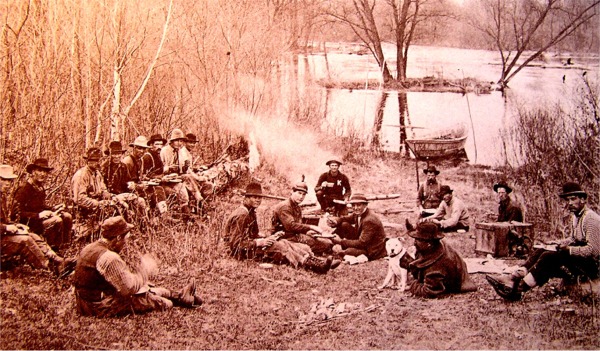The Eau Claire: Eau Claire River Series
-
Difficulty:
-

-
Terrain:
-

Size:  (regular)
(regular)
Please note Use of geocaching.com services is subject to the terms and conditions
in our disclaimer.

Taking it easy about 1905 on the banks of the Eau Claire river;
forerunner of the modern "coffee break".
150 years ago much of life centered around the Eau Claire river in
this area. The river provided transportation for people and
supplies, and also brought the logs to numerous mills that sprang
up along its banks. Today little remains of those days and the
river seems to meander through the Town of Weston almost unnoticed.
This series of caches is our attempt to bring some attention back
to the river and the history along its banks.
This cache is located on an island in the Eau Claire river. To
access this cache during the summer you will need a kayak, canoe,
or small boat. There is a boat landing (daily fee)located at:
N44 55.003 W089 36.500
Alternatively you could do this as a short river trip by putting in
at Yellow Banks (and there's a cache there!)
N44 44.694 W089 34.427
and paddling down river to the boat landing mentioned before. The
river is quite beautiful in the spring though, in the summer, with
the water low the river trip may be difficult and you may encounter
algae bloom and insects making the trip less enjoyable.
_______________________________________________________
Following information is from the year 1959
Taken from “Weston Centennial 1859-1959”
Weston’s Eau Claire River
One hundred years ago the town of Weston encompassed a great
mileage of the Eau Claire river, and it was near the confluence of
the Eau Clare and Wisconsin rivers that the present town’s early
history started.
In those days there were numerous living springs and the entire
Eau Claire river bottomland and for miles inland the virgin pine
forests extended, holding the water which kept the springs
alive.
The annual flow of the river was much greater than in recent years
due to those sparkling clear springs.
With the absence of dams all down the Wisconsin river at that
time, fish from the Mississippi were free to make their way to the
upper reaches of the Eau Claire.
At times the fishing was excellent, and since there were no
restrictions or fish and game laws, every method was used to get
fish for food. Spearing was a favorite method and even the so
called snag lines came into use.
The snag lines were a series of hooks on a strong main line
itself, or just as often the hooks were on smaller drop-lines from
the main one. These hooks were not baited. During the spawning
seasons, and especially of walleyes and sturgeon, the fish like to
rub, and when finding the lines would often play around them and
become impaled on the bare hooks. It was a somewhat cruel method of
catching fish- and has been done illegally over the years,
especially in Wisconsin’s Wolf river- but is almost unknown in most
areas today.
We must remember that fishing in those early days was far more a
food necessity than sport. In fact, many families were forced to
survive on a diet of fish at times, and they were a welcome protein
in spring, to break the monotony of meat, dried fruit, beans, peas,
even in lush years.
Many of the creeks along the Eau Claire were teeming with native
brook trout, but as the timber was cut, stream flow lessoned, then
the water itself warmed, due to lack of cover and the added flow,
trout were soon on the downgrade. By 1900 this was already
affecting the trout supply, and a number of years of planting trout
has been more failure than success. Once the natural habitat is
meddled with and practically ruined, trout simply cannot exist.
Today we find a few trout in the feeder streams of the Eau Claire,
yet, for all purposes, trout fishing is very poor by comparison
with those early days...
Unlike many streams, the Eau Claire is clear and practically
unpolluted, while its big brother, the Wisconsin river, has a
deeper hue and carries heavy pollution. Anti-pollution laws were
enacted many years ago, and in recent years a real effort has been
made to lessen stream contamination and some progress has occurred.
Yet, clear streams and rivers in the state are still many years
away; and may never be accomplished in some cases. Thus, the Eau
Claire, with its clear water and freedom from pollution in this
year 1959, is a real asset to the town of Weston. Except for the
amount of flow, which is considerably less, the Eau Claire is
little changed from one hundred years ago.
A short distance west of Weston the Eau Claire forms a favorite
pond and swimming pool above the dam at Schofield.
Thoroughfare to Modern Asset
So, if we consider the Eau Claire river from its earliest history,
when if formed the very thoroughfare of the territory and carried
the labor of thousands of loggers and lumbermen over the years, it
has remained a very important natural asset to the town of
Weston.
The Town, in turn, can be, and is, proud that the Eau Claire has
not been abused; that it remains a living memorial of good practice
and adherence to the stat’s important riparian water concept and
laws.
Few remains are evident of the many mills or the vast timber along
its shores, but the Eau Claire flows steadily on, never to be
forgotten for the important part it played in the establishment of
the town of Weston as the thriving, modern township of today.
Additional Hints
(No hints available.)